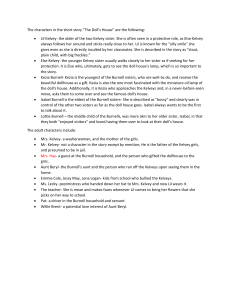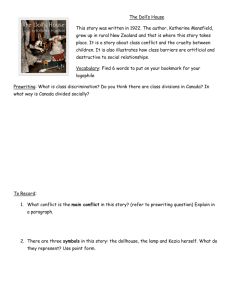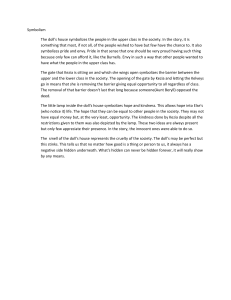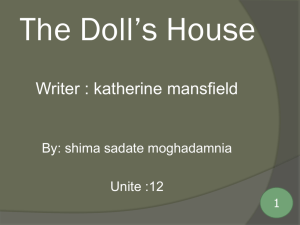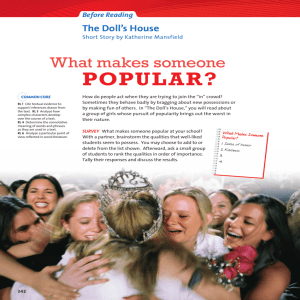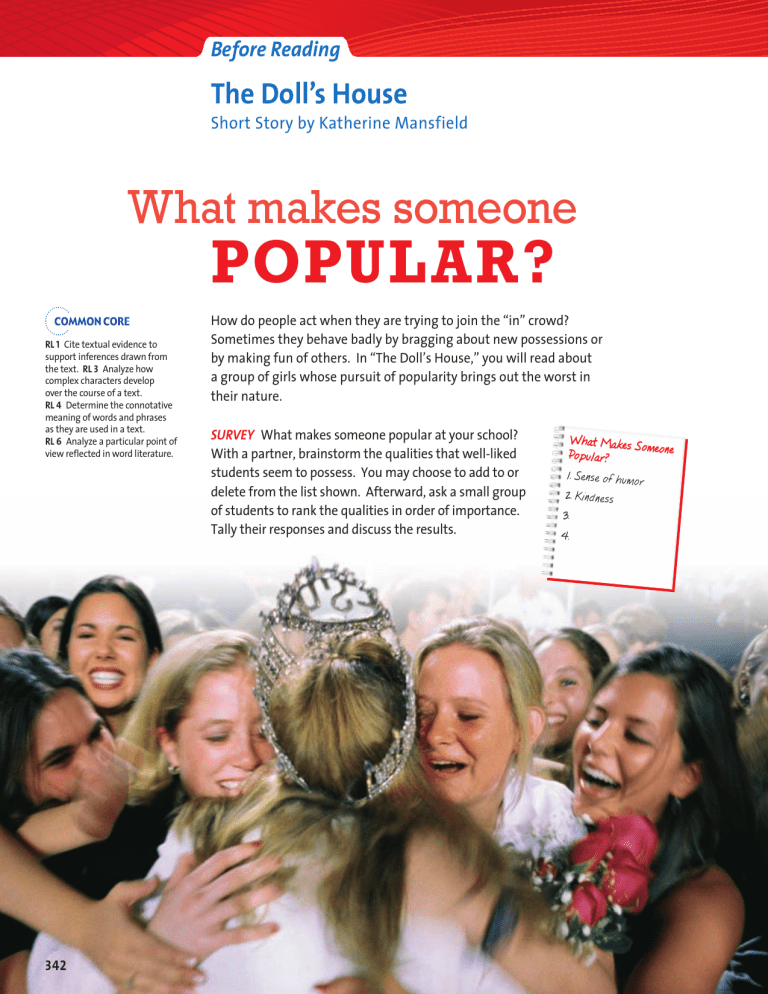
Before Reading The Doll’s House Short Story by Katherine Mansfield What makes someone POPULAR? RL 1 Cite textual evidence to support inferences drawn from the text. RL 3 Analyze how complex characters develop over the course of a text. RL 4 Determine the connotative meaning of words and phrases as they are used in a text. RL 6 Analyze a particular point of view reflected in word literature. 342 How do people act when they are trying to join the “in” crowd? Sometimes they behave badly by bragging about new possessions or by making fun of others. In “The Doll’s House,” you will read about a group of girls whose pursuit of popularity brings out the worst in their nature. SURVEY What makes someone popular at your school? With a partner, brainstorm the qualities that well-liked students seem to possess. You may choose to add to or delete from the list shown. Afterward, ask a small group of students to rank the qualities in order of importance. Tally their responses and discuss the results. What Makes Someone Popular? 1. Sens e of hum 2. Kindness 3. 4. or Meet the Author text analysis: omniscient point of view A story written from the third-person point of view has a narrator who is not a character but an outside observer. Sometimes this type of narrator is omniscient, or all knowing, and has the power to reveal the thoughts and feelings of more than one character. In “The Doll’s House,” for example, the omniscient narrator describes the private wishes of several characters, including those of the Burnell children. The Burnell children could hardly walk to school fast enough the next morning. They burned to tell everybody, to describe, to— well—to boast about their doll’s house before the school bell rang. Unlike stories written from the first-person point of view, stories with an omniscient point of view offer a wider, and perhaps more reliable, perspective. Writers often use such a point of view when they wish to examine broad social issues. As you read the story, think about how its point of view affects the tone of the story. Consider how the writer’s ability to show the thoughts and perspective of all of the characters in the story allows her to reveal her attitude toward the events she describes. Review: Symbol reading strategy: connect When you connect to a story, you relate its content to your own knowledge and experiences. This strategy can deepen your understanding of the characters, their actions, and the story’s overall message. As you read “The Doll’s House,” make connections between the characters’ world and your own. Record your observations in a chart like the one shown. Characters’ Experiences My Experiences The Burnell girls are thrilled by the doll’s house. I felt excited when my parents gave me my first bike. Katherine Mansfield 1888–1923 A Bold Spirit Born Kathleen Beauchamp in Wellington, New Zealand, Katherine Mansfield was the third child of a wealthy merchant father and a class- conscious mother. When she was five, her family moved to the rural settlement of Karori, where she excelled in the artistic pursuits of writing and playing the cello. Although Mansfield enjoyed country life, she felt constrained by her family’s traditional values. A fiercely independent teen, Mansfield, at 19, settled in London, England. There she enjoyed great creative freedom. Breaking New Ground Although she lived only to the age of 34, Mansfield was a master of the short story and developed a distinctive prose style. Her best works reflect her use of experimental narrative techniques to offer vivid insights into characters’ thoughts. Mansfield never returned to New Zealand, though she remained close to her homeland in spirit. Many of her stories, including “The Doll’s House,” recall her childhood experiences. background to the story The Better Sort This story is set in the late 1800s in New Zealand, which was then a colony of Great Britain. When the British emigrated there, they took with them not only their possessions but the social prejudices of their native land. At the time,, British society was divided along rigid class lines. Birth u usually determined a person’s class, and climbing clim the social scale was difficult. In her fi fiction, Mansfield criticized this elitist system system. Review: Make Inferences Complete the activities in your Reader/Writer Notebook. Author Online Go to thinkcentra thinkcentral.com.. KEYWORD: HML10 HML10-343 343 THE oll’s ouse Katherine Mansfield 10 20 When dear old Mrs. Hay went back to town after staying with the Burnells she sent the children a doll’s house. It was so big that the carter1 and Pat carried it into the courtyard, and there it stayed, propped up on two wooden boxes beside the feed-room door. No harm could come to it; it was summer. And perhaps the smell of paint would have gone off by the time it had to be taken in. For, really, the smell of paint coming from that doll’s house (“Sweet of old Mrs. Hay, of course; most sweet and generous!”)—but the smell of paint was quite enough to make any one seriously ill, in Aunt Beryl’s opinion. Even before the sacking was taken off. And when it was. . . . a There stood the doll’s house, a dark, oily, spinach green, picked out with bright yellow. Its two solid little chimneys, glued on to the roof, were painted red and white, and the door, gleaming with yellow varnish, was like a little slab of toffee. Four windows, real windows, were divided into panes by a broad streak of green. There was actually a tiny porch, too, painted yellow, with big lumps of congealed paint hanging along the edge. But perfect, perfect little house! Who could possibly mind the smell? It was part of the joy, part of the newness. “Open it quickly, some one!” The hook at the side was stuck fast. Pat pried it open with his penknife, and the whole house front swung back, and—there you were, gazing at one and the same moment into the drawing room and dining room, the kitchen and two bedrooms. That is the way for a house to open! Why don’t all houses open like that? How much more exciting than peering through the slit of a door into a mean little hall with a hat stand and two umbrellas! That is—isn’t it?—what you long to know about a house when you put your hand on the knocker. Perhaps it is the way God opens houses at dead of night when He is taking a quiet turn with an angel. . . . “O-oh!” The Burnell children sounded as though they were in despair. It was too marvelous; it was too much for them. They had never seen anything 1. carter: delivery person. 344 unit 3: narrative devices Think about the purpose of a doll’s house like the one shown. Would it be regularly played with or displayed for company? Explain. a POINT OF VIEW Reread lines 1–9. What do you learn about the doll’s house from the direct comments of the narrator? 30 40 like it in their lives. All the rooms were papered. There were pictures on the walls, painted on the paper, with gold frames complete. Red carpet covered all the floors except the kitchen; red plush chairs in the drawing room, green in the dining room; tables, beds with real bedclothes, a cradle, a stove, a dresser with tiny plates and one big jug. But what Kezia liked more than anything, what she liked frightfully, was the lamp. It stood in the middle of the dining room table, an exquisite little amber lamp with a white globe. It was even filled all ready for lighting, though, of course, you couldn’t light it. But there was something inside that looked like oil, and that moved when you shook it. b The father and mother dolls, who sprawled very stiff as though they had fainted in the drawing room, and their two little children asleep upstairs, were really too big for the doll’s house. They didn’t look as though they belonged. But the lamp was perfect. It seemed to smile at Kezia, to say, “I live here.” The lamp was real. b Think back to the excitement you felt when you received a favorite gift. On the basis of your experience, do you find the Burnells’ reactions to the doll’s house believable? Why, or why not? 50 60 70 he Burnell children could hardly walk to school fast enough the next morning. They burned to tell everybody, to describe, to—well—to boast about their doll’s house before the school bell rang. “I’m to tell,” said Isabel, “because I’m the eldest. And you two can join in after. But I’m to tell first.” There was nothing to answer. Isabel was bossy, but she was always right, and Lottie and Kezia knew too well the powers that went with being eldest. They brushed through the thick buttercups at the road edge and said nothing. “And I’m to choose who’s to come and see it first. Mother said I might.” For it had been arranged that while the doll’s house stood in the courtyard they might ask the girls at school, two at a time, to come and look. Not to stay to tea, of course, or to come traipsing through the house. But just to stand quietly in the courtyard while Isabel pointed out the beauties, and Lottie and Kezia looked pleased. . . . c But hurry as they might, by the time they had reached the tarred palings2 of the boys’ playground the bell had begun to jangle. They only just had time to whip off their hats and fall into line before the roll was called. Never mind. Isabel tried to make up for it by looking very important and mysterious and by whispering behind her hand to the girls near her, “Got something to tell you at playtime.” Playtime came and Isabel was surrounded. The girls of her class nearly fought to put their arms around her, to walk away with her, to beam flatteringly, to be her special friend. She held quite a court under the huge pine trees at the side of the playground. Nudging, giggling together, the little girls pressed up close. And the only two who stayed outside the ring were the two who were always outside, the little Kelveys. They knew better than to come anywhere near the Burnells. 2. palings: fence stakes. 346 unit 3: narrative devices CONNECT c POINT OF VIEW Reread lines 44–57. Notice what the omniscient narrator reveals about the Burnells. How does this information shape your opinion of the girls? The Daughters of Edward Darley Boit (1882), John Singer Sargent. Oil on canvas, 221.93 × 222.57 cm. Gift of Mary Louisa Boit, Julia Overing Boit, Jane Hubbard Boit and Florence D. Boit in memory of Edward Darley Boit. Museum of Fine Arts, Boston. Photo © Museum of Fine Arts, Boston. For the fact was, the school the Burnell children went to was not at all the kind of place their parents would have chosen if there had been any choice. But there was none. It was the only school for miles. And the consequence was all the children in the neighborhood, the Judge’s little girls, the doctor’s daughters, the storekeeper’s children, the milkman’s, were forced to mix together. Not to speak of there being an equal number of rude, rough little boys as well. But the line had to be drawn somewhere. It was drawn at the Kelveys. Many of the children, including the Burnells, were not allowed even to speak to them. They walked past the Kelveys with their heads in the air, and Examine the figures and the setting in the painting. How well do they match your impression of the people and furnishings of the Burnell household? Explain. the doll’s house 347 80 90 100 110 120 as they set the fashion in all matters of behavior, the Kelveys were shunned by everybody. Even the teacher had a special voice for them, and a special smile for the other children when Lil Kelvey came up to her desk with a bunch of dreadfully common-looking flowers. d They were the daughters of a spry, hardworking little washerwoman, who went about from house to house by the day. This was awful enough. But where was Mr. Kelvey? Nobody knew for certain. But everybody said he was in prison. So they were the daughters of a washerwoman and a jailbird. Very nice company for other people’s children! And they looked it. Why Mrs. Kelvey made them so conspicuous was hard to understand. The truth was they were dressed in “bits” given to her by the people for whom she worked. Lil, for instance, who was a stout, plain child, with big freckles, came to school in a dress made from a green art-serge3 tablecloth of the Burnells’, with red plush sleeves from the Logans’ curtains. Her hat, perched on top of her high forehead, was a grown-up woman’s hat, once the property of Miss Lecky, the postmistress. It was turned up at the back and trimmed with a large scarlet quill. What a little guy4 she looked! It was impossible not to laugh. And her little sister, our Else, wore a long white dress, rather like a nightgown, and a pair of little boy’s boots. But whatever our Else wore she would have looked strange. She was a tiny wishbone of a child, with cropped hair and enormous solemn eyes—a little white owl. Nobody had ever seen her smile; she scarcely ever spoke. She went through life holding on to Lil, with a piece of Lil’s skirt screwed up in her hand. Where Lil went our Else followed. In the playground, on the road going to and from school, there was Lil marching in front and our Else holding on behind. Only when she wanted anything, or when she was out of breath, our Else gave Lil a tug, a twitch, and Lil stopped and turned around. The Kelveys never failed to understand each other. e Now they hovered at the edge; you couldn’t stop them listening. When the little girls turned round and sneered, Lil, as usual, gave her silly, shamefaced smile, but our Else only looked. And Isabel’s voice, so very proud, went on telling. The carpet made a great sensation, but so did the beds with real bedclothes, and the stove with an oven door. When she finished Kezia broke in. “You’ve forgotten the lamp, Isabel.” “Oh, yes,” said Isabel, “and there’s a teeny little lamp, all made of yellow glass, with a white globe that stands on the dining room table. You couldn’t tell it from a real one.” “The lamp’s best of all,” cried Kezia. She thought Isabel wasn’t making half enough of the little lamp. But nobody paid attention. Isabel was choosing the two who were to come back with them that afternoon and see it. She chose Emmie Cole and Lena Logan. But when the others knew they were all to have 3. art-serge (ärt-sûrj): a type of woven wool. 4. guy: British term for an odd-looking person. 348 unit 3: narrative devices d POINT OF VIEW What do you learn about the townspeople? Explain how the omniscient point of view allows you to see problems that may affect an entire community. What do you think is the writer’s attitude toward the townspeople? toward the Kelveys? e CONNECT Reread lines 84–106. Find details that explain why the Kelveys are disliked. How might Lil and Else be treated at your school? a chance, they couldn’t be nice enough to Isabel. One by one they put their arms round Isabel’s waist and walked her off. They had something to whisper to her, a secret. “Isabel’s my friend.” Only the little Kelveys moved away forgotten; there was nothing more for them to hear. 130 Days passed, and as more children saw the doll’s house, the fame of it spread. It became the one subject, the rage. The one question was, “Have you seen Burnells’ doll’s house? Oh, ain’t it lovely!” “Haven’t you seen it? Oh, I say!” Even the dinner hour was given up to talking about it. The little girls sat under the pines eating their thick mutton sandwiches and big slabs of johnny cake spread with butter. While always, as near as they could get, sat the Kelveys, our Else holding on to Lil, listening too, while they chewed their jam sandwiches out of a newspaper soaked with large red blobs. . . . “Mother,” said Kezia, “can’t I ask the Kelveys just once?” “Certainly not, Kezia.” “But why not?” “Run away, Kezia; you know quite well why not.” f f MAKE INFERENCES Think about how Kezia’s family acts toward her. Why might she want to share the doll’s house with the Kelveys? 150 t last everybody had seen it except them. On that day the subject rather flagged. It was the dinner hour. The children stood together under the pine trees, and suddenly, as they looked at the Kelveys eating out of their paper, always by themselves, always listening, they wanted to be horrid to them. Emmie Cole started the whisper. “Lil Kelvey’s going to be a servant when she grows up.” “O-oh, how awful!” said Isabel Burnell, and she made eyes at Emmie. Emmie swallowed in a very meaning way and nodded to Isabel as she’d seen her mother do on those occasions. “It’s true—it’s true—it’s true,” she said. Then Lena Logan’s little eyes snapped. “Shall I ask her?” she whispered. “Bet you don’t,” said Jessie May. “I’m not frightened,” said Lena. Suddenly she gave a little squeal and danced in front of the other girls. “Watch! Watch me! Watch me now!” said Lena. And sliding, gliding, dragging one foot, giggling behind her hand, Lena went over to the Kelveys. Lil looked up from her dinner. She wrapped the rest quickly away. Our Else stopped chewing. What was coming now? “Is it true you’re going to be a servant when you grow up, Lil Kelvey?” shrilled Lena. the doll’s house 349 160 170 Dead silence. But instead of answering, Lil only gave her silly, shamefaced smile. She didn’t seem to mind the question at all. What a sell for Lena! The girls began to titter. Lena couldn’t stand that. She put her hands on her hips; she shot forward. “Yah, yer father’s in prison!” she hissed, spitefully. This was such a marvelous thing to have said that the little girls rushed away in a body, deeply, deeply excited, wild with joy. Someone found a long rope, and they began skipping. And never did they skip so high, run in and out so fast, or do such daring things as on that morning. In the afternoon Pat called for the Burnell children with the buggy and they drove home. There were visitors. Isabel and Lottie, who liked visitors, went upstairs to change their pinafores. But Kezia thieved out at the back. Nobody was about; she began to swing on the big white gates of the courtyard. Apple Picking (1878), Winslow Homer. Watercolor and gouache on paper, laid down on board, 7˝ × 83/8˝. Daniel J. Terra Collection 1992.7. Photo © Terra Foundation for American Art, Chicago, Illinois/Art Resource, New York. 350 unit 3: narrative devices RL 4 Language Coach Denotation/Connotation The images or feelings connected to a word are its connotations. Reread lines 159–160. How do you think the girls are feeling as they titter? Why do you think the author chose this word instead of laugh? 180 190 200 210 Presently, looking along the road, she saw two little dots. They grew bigger, they were coming towards her. Now she could see that one was in front and one close behind. Now she could see that they were the Kelveys. Kezia stopped swinging. She slipped off the gate as if she was going to run away. Then she hesitated. The Kelveys came nearer, and beside them walked their shadows, very long, stretching right across the road with their heads in the buttercups. Kezia clambered back on the gate; she had made up her mind; she swung out. “Hullo,” she said to the passing Kelveys. They were so astounded that they stopped. Lil gave her silly smile. Our Else stared. “You can come and see our doll’s house if you want to,” said Kezia, and she dragged one toe on the ground. But at that Lil turned red and shook her head quickly. “Why not?” asked Kezia. Lil gasped, then she said, “Your ma told our ma you wasn’t to speak to us.” “Oh well,” said Kezia. She didn’t know what to reply. “It doesn’t matter. You can come and see our doll’s house all the same. Come on. Nobody’s looking.” But Lil shook her head still harder. “Don’t you want to?” asked Kezia. Suddenly there was a twitch, a tug at Lil’s skirt. She turned round. Our Else was looking at her with big, imploring eyes; she was frowning; she wanted to go. For a moment Lil looked at our Else very doubtfully. But then our Else twitched her skirt again. She started forward. Kezia led the way. Like two little stray cats they followed across the courtyard to where the doll’s house stood. g “There it is,” said Kezia. There was a pause. Lil breathed loudly, almost snorted; our Else was still as a stone. “I’ll open it for you,” said Kezia kindly. She undid the hook and they looked inside. “There’s the drawing room and the dining room, and that’s the—” “Kezia!” Oh, what a start they gave! “Kezia!” It was Aunt Beryl’s voice. They turned round. At the back door stood Aunt Beryl, staring as if she couldn’t believe what she saw. “How dare you ask the little Kelveys into the courtyard?” said her cold, furious voice. “You know as well as I do, you’re not allowed to talk to them. Run away, children, run away at once. And don’t come back again,” said Aunt Beryl. And she stepped into the yard and shooed them out as if they were chickens. “Off you go immediately!” she called, cold and proud. h g MAKE INFERENCES Reread lines 190–194. Notice how Lil responds to Else. What does this tell you about their relationship? h CONNECT Aunt Beryl forbids Kezia to play with the Kelveys. How would you respond if you were in Kezia’s position? the doll’s house 351 220 230 They did not need telling twice. Burning with shame, shrinking together, Lil huddling along like her mother, our Else dazed, somehow they crossed the big courtyard and squeezed through the white gate. “Wicked, disobedient little girl!” said Aunt Beryl bitterly to Kezia, and she slammed the doll’s house to. The afternoon had been awful. A letter had come from Willie Brent, a terrifying, threatening letter, saying if she did not meet him that evening in Pulman’s Bush, he’d come to the front door and ask the reason why! But now that she had frightened those little rats of Kelvey’s and given Kezia a good scolding, her heart felt lighter. That ghastly pressure was gone. She went back to the house humming. i When the Kelveys were well out of sight of the Burnells’, they sat down to rest on a big red drainpipe by the side of the road. Lil’s cheeks were still burning; she took off the hat with the quill and held it on her knee. Dreamily they looked over the hay paddocks,5 past the creek, to the group of wattles6 where Logan’s cows stood waiting to be milked. What were their thoughts? Presently our Else nudged up close to her sister. But now she had forgotten the cross lady. She put out a finger and stroked her sister’s quill; she smiled her rare smile. “I seen the little lamp,” she said, softly. j Then both were silent once more. 5. paddocks (pBdPEks): areas of fenced-in land. 6. wattles (wJtPlz): acacia trees. 352 unit 3: narrative devices i POINT OF VIEW Reread lines 204–221. What does the omniscient narrator reveal about Aunt Beryl and her motives for treating the Kelveys so poorly? How does this contribute to the tone of the story? RL 6 j WORLD LITERATURE Mansfield grew up in New Zealand and many of her stories recall her childhood experiences. Reread the Background to the Story on page 343. Do you think the situation in this story could still happen today, with children anywhere in the world? After Reading Comprehension 1. Recall Describe the doll’s house that the Burnells receive. 2. Recall Under what conditions are the girls’ friends allowed to see the doll’s house? 3. Recall Why are the Burnells not allowed to speak to the Kelveys? RL 1 Cite textual evidence to support inferences drawn from the text. RL 3 Analyze how complex characters develop over the course of a text. RL 6 Analyze a particular point of view reflected in world literature. 4. Clarify Why does Else smile at the end of the story? Text Analysis 5. Compare and Contrast Characters What are the similarities and differences between Isabel Burnell and Lil Kelvey? Use a Venn diagram like the one shown to explore your answer. Isabel Both Lil 6. Identify Symbol A person, a place, or an object that represents something beyond itself is a symbol. Two objects that might be considered symbols in this story are the doll’s house and the little lamp. What values do these objects symbolize? 7. Draw Conclusions About Theme Think about the story’s theme, or main message. What does the story reveal about popularity? Use evidence to support your conclusion. 8. Connect Writing “The Doll’s House,” Mansfield painted a picture of traditional New Zealand society. Despite the different location and time period, how are the characters, events, and ideas presented in the story relevant to your own experiences? Review the chart you completed as you read. Support your answer with information from the chart and the story. 9. Analyze Point of View In the story, the omniscient narrator sees into the minds of several of the story’s characters. How might your sense of the town and its residents be different if the story were told through the eyes of just one character—Aunt Beryl, for example? How would this affect the story’s tone? Text Criticism 10. Critical Interpretations “The notion that human beings adopt masks and present themselves to their fellows under assumed personalities,” wrote one biographer, “was one of [Mansfield’s] literary obsessions.” How does this comment apply to the story? Cite specific examples to support your answer. What makes someone POPULAR? What are some positive ways to achieve popularity? the doll’s house 353
